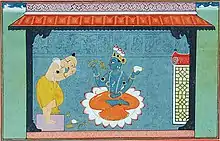| Periya Tiruvantati | |
|---|---|
.jpg.webp) Painting of Krishna among the milkmaids of Vraja, the gopis. Museum of Oriental Art, Rome. | |
| Information | |
| Religion | Hinduism |
| Author | Nammalvar |
| Language | Tamil |
| Period | 9th–10th century CE |
| Verses | 87 |
The Periya Tiruvantati (Tamil: பெரிய திருவந்தாதி, romanized: Periya Tiruvantāti, lit. 'The great sacred verse' ⓘ)[1] is a compilation of hymns written by Nammalvar, one of the Alvars, the poet-saints of the Sri Vaishnava tradition.[2] This work, which is a part of the Nalayira Divya Prabandham,[3] consists of eighty-seven hymns[4][5] referred to as pasurams, dedicated to the praise of the Hindu preserver deity, Vishnu. It is often regarded to contain the essence of the Atharvaveda.[6][7]
Hymns
| Part of a series on |
| Vaishnavism |
|---|
 |
The hymns of the Periya Tiruvantati are written in the poetic style called the antati, in which a new verse is linked with the last word of the preceding verse.[8]
There are two theories that seek to explain the name of this text, both of which are drawn from hymns within the work. In the fifty-sixth hymn of the Periya Tiruvantati, Nammalvar asserts his belief that the performance of prapatti alone is enough to receive the protection of the deity Krishna. This is interpreted to be the essence of the charama shlokam, an ontological hymn, which is regarded to be of such significance that the antati was henceforth deemed to be great. In the seventy-fifth hymn of this work, Nammalvar engages in a theological conversation with Vishnu, where he acknowledges his attributes. As a metaphor of devotion, he states that he had deftly captured the deity in his heart, a deity who had captured the entire world. Thus, he rhetorically wonders who among the two of them was greater, lending this question to the name of the text.[9]
The forty-ninth hymn of the Periya Tiruvantati describes Nammalvar's perception of Krishna:[10]
Whenever I see the dark clouds, or the dark mountains, or the deep ocean, or the dark night, or the bee-humming Kaya flower, or anything else of dark hue, my heart leaves me and flies out, saying, “This is Krishna’s glorious form"
— Periya Tiruvantati, Hymn 49
See also
| Topics in Tamil literature | ||
|---|---|---|
| Sangam Literature | ||
| Five Great Epics | ||
| Silappatikaram | Manimekalai | |
| Civaka Cintamani | Valayapathi | |
| Kundalakesi | ||
| The Five Minor Epics | ||
| Neelakesi | Culamani | |
| Naga Kumara Kaviyam | Udayana Kumara Kaviyam | |
| Yashodhara Kaviyam | ||
| Bhakti Literature | ||
| Naalayira Divya Prabandham | Kamba Ramayanam | |
| Tevaram | Tirumurai | |
| Tamil people | ||
| Sangam | Sangam landscape | |
| Tamil history from Sangam literature | Ancient Tamil music | |
References
- ↑ Reṭṭiyār, Na Cuppu; Reddiar, Nallappa Subbu (1977). Religion and Philosophy of Nālāyira Divya Prabandham with Special Reference to Nammālvār. Sri Venkateswara University. p. 256.
- ↑ Klostermaier, Klaus K. (2010-03-10). A Survey of Hinduism: Third Edition. State University of New York Press. p. 253. ISBN 978-0-7914-8011-3.
- ↑ Nayar, Nancy Ann (1992). Poetry as Theology: The Śrīvaiṣṇava Stotra in the Age of Rāmānuja. Otto Harrassowitz Verlag. p. 33. ISBN 978-3-447-03255-1.
- ↑ Raman, Srilata (2007-01-24). Self-Surrender (prapatti) to God in Shrivaishnavism: Tamil Cats Or Sanskrit Monkeys?. Routledge. p. 20. ISBN 978-1-134-16538-4.
- ↑ Spuler, Bertold (1975). Handbook of Oriental Studies. BRILL. p. 154. ISBN 978-90-04-04190-5.
- ↑ Narayanan, Vasudha; Nammaaolvaar (1994). The Vernacular Veda: Revelation, Recitation, and Ritual. Univ of South Carolina Press. p. 36. ISBN 978-0-87249-965-2.
- ↑ Younger, Paul (2002). Playing Host to Deity: Festival Religion in the South Indian Tradition. Oxford University Press. p. 89. ISBN 978-0-19-514044-6.
- ↑ Nammalwar (2014-05-15). A Hundred Measures of Time: Tiruviruttam. Penguin UK. p. 86. ISBN 978-93-5118-714-1.
- ↑ Sathakopan, SrI Varadachari. Periya Thiruvandhathi & Atharvana Vedam - Annotated Commentary in English (PDF). Oppiliappan Koil. pp. 3–4.
- ↑ Makarand Joshi. The Sacred Book Of Four Thousand 01 Nalayira Divya Prabandham Sri Rama Bharati 2000. p. 712.